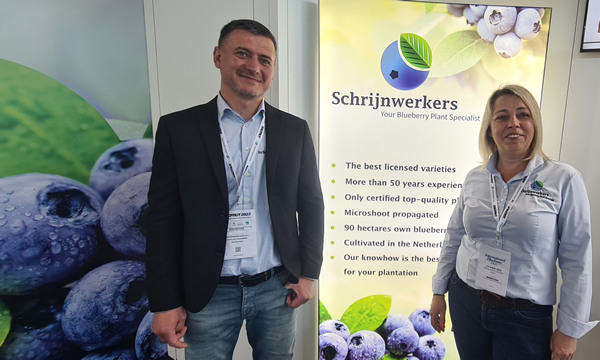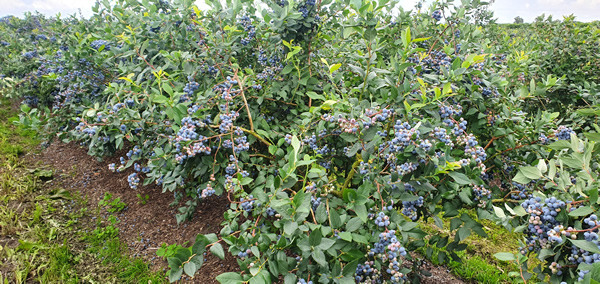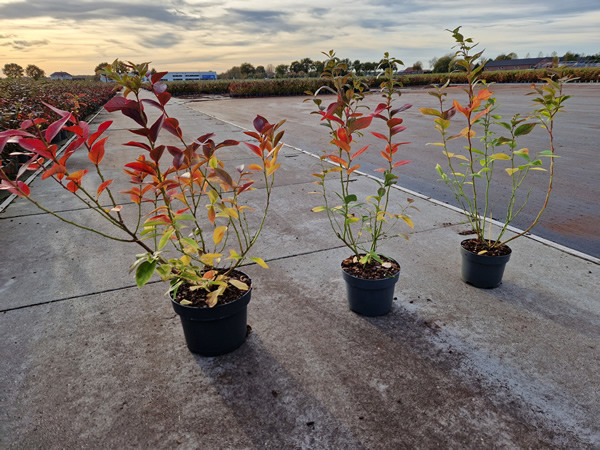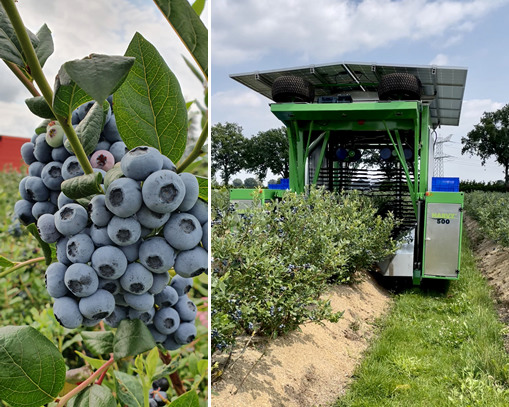Every year, Schrijnwerkers Plants propagates about 1.5 million blueberry plants for the European market on its Dutch production site. In recent decades, the company has built up an extensive portfolio of early, medium, and late varieties. Although berry cultivation has expanded tremendously worldwide in recent years, saleswoman Aleksandra Neumann still sees much growth potential. "There are still people who don't know about blueberries," she begins.

Stanislaw Inzoskowski and Aleksandra Neumann at Macfrut
This year, Schrijnwerkers participated in Macfrut in Rimini, Italy, for the first time. "Italy cultivates quite a lot of blueberries. Our plants are only suitable for growers in northern Italy because we propagate the so-called high-chill varieties. These need 800 to 1,000 chill hours; that's not possible in the south of the country."
Schrijnwerkers grows Dutch General Inspection Service (NAK) certified plant material and the latest licensed varieties, with which, says Aleksandra, they meet the whole of Europe and beyond's needs. "In the past, plant material was tinkered with quite a bit, which caused incalculable damage. Planting a hectare cost a lot of money and is a long-term investment. That's why everyone now wants the best plants," she explains.

Plants in full production within five years
The nursery's plants come into full production in their fifth growth year. "Most growers plant biennial plants. If planted in the spring, they produce in the summer. The first year it's only 300 grams; a year later, a kilo more, and that increases to six kg when the plant's in full production." Night frost remains a danger to the blossom, though, according to Aleksandra, the berries can tolerate frost better than, say, apple trees. "They can handle a few degrees of frost well," she says.
Schrijnwerkers is currently experiencing considerable growth in the Polish market, where many old apple orchards are being uprooted to make way for blueberries. "But we sell our plants in more than 30 countries, from Sweden to Greece, and also outside Europe in countries like Kazakhstan, Armenia, and Georgia. In Portugal, the first berries are sometimes harvested as early as late May; countries like Romania and Serbia follow in late June. We finish in September with the later varieties."

Pandemic, war lower willingness to invest
Aleksandra says the previous season's berry prices affect how many plants are sold. "If those were good, we sell more plants. However, companies have become more cautious about investments because of the war, inflation, and higher cost and energy prices. They prefer to wait a year before deciding, which has undoubtedly slowed investments," she continues.
Neumann cites finding labor as the berry sector's biggest challenge. "That doesn't apply to our nursery, where everything's so automated we don't need as many people. But finding people to pick the berries is a major challenge. We're, therefore, convinced that machine picking is the future, also for the fresh market."
"That's why most plants are already planted on ridges so they can be machine harvested," Aleksandra says. "The latest machines on the market pick the best quality berries, replacing 50 people. By using the best sorters, the quality's the same or better than hand picking."

In strawberries' wake
Even though global blueberry cultivation has grown explosively recently, Aleksandra still sees many market expansion opportunities. "There are still people who don't know blueberries. I hope blueberries follow in strawberries' wake. Just compare America and the Netherlands' blueberry consumption. There's such a huge difference. So, there's still a world to win," she concludes.
 For more information:
For more information:
Aleksandra Neumann
Schrijnwerkers Plants
56 Vierlingsbeekseweg
5825 AX, Overloon, NL
Mob: +31 (0) 630 127 791
Email: info@schrijnwerkers.nl
Website: www.schrijnwerkers.nl
